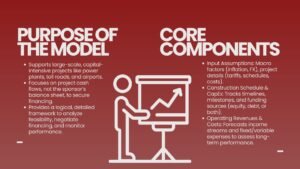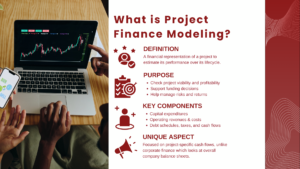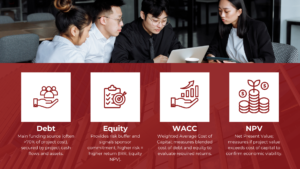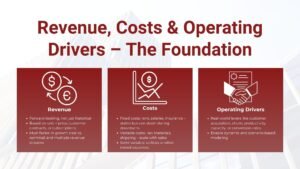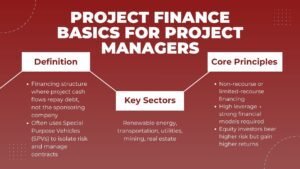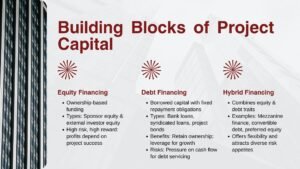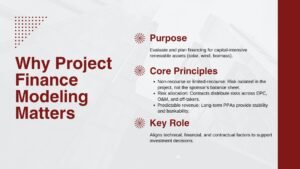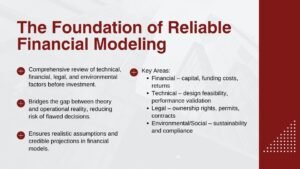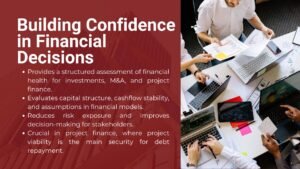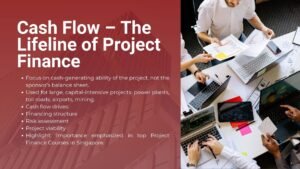Understanding the Structure and Logic of a Project Finance Model
Understanding the Structure and Logic of a Project Finance Model
The analytical basis of infrastructure, renewable energy and capital-intensive ventures around the globe is made up of infrastructure project finance models. These models allow the stakeholders in the project to determine the financial viability, bankability and change resilience of the project by making them realize whether the project is a bankable and change resilient venture or not. In its basic form, a project finance model is a detailed financial model of project life cycle. It has an ability to transform technical assumptions and even commercial agreements into measurable financial results and aids decision makers to foresee risks and rewards.
Knowing how a project finance model is organized and logically presented is fundamental to all persons interested in a long-term infrastructure or energy transaction. Participating in a project finance modeling training Singapore helps individuals understand how the structure of the model should reflect the real workings of the project—showing how revenues are gained, how expenditures are incurred, and how funding requirements are fulfilled. A well-organized theory is not a mathematical device—it is a clear system of communication that enables everyone to witness how hypotheses are transformed into outputs.
In this paper, the author discusses the design and logic behind project finance models, the principles of their construction, why they are dependable, and why an in-depth view of the flow is essential in making good financial decisions and investments.
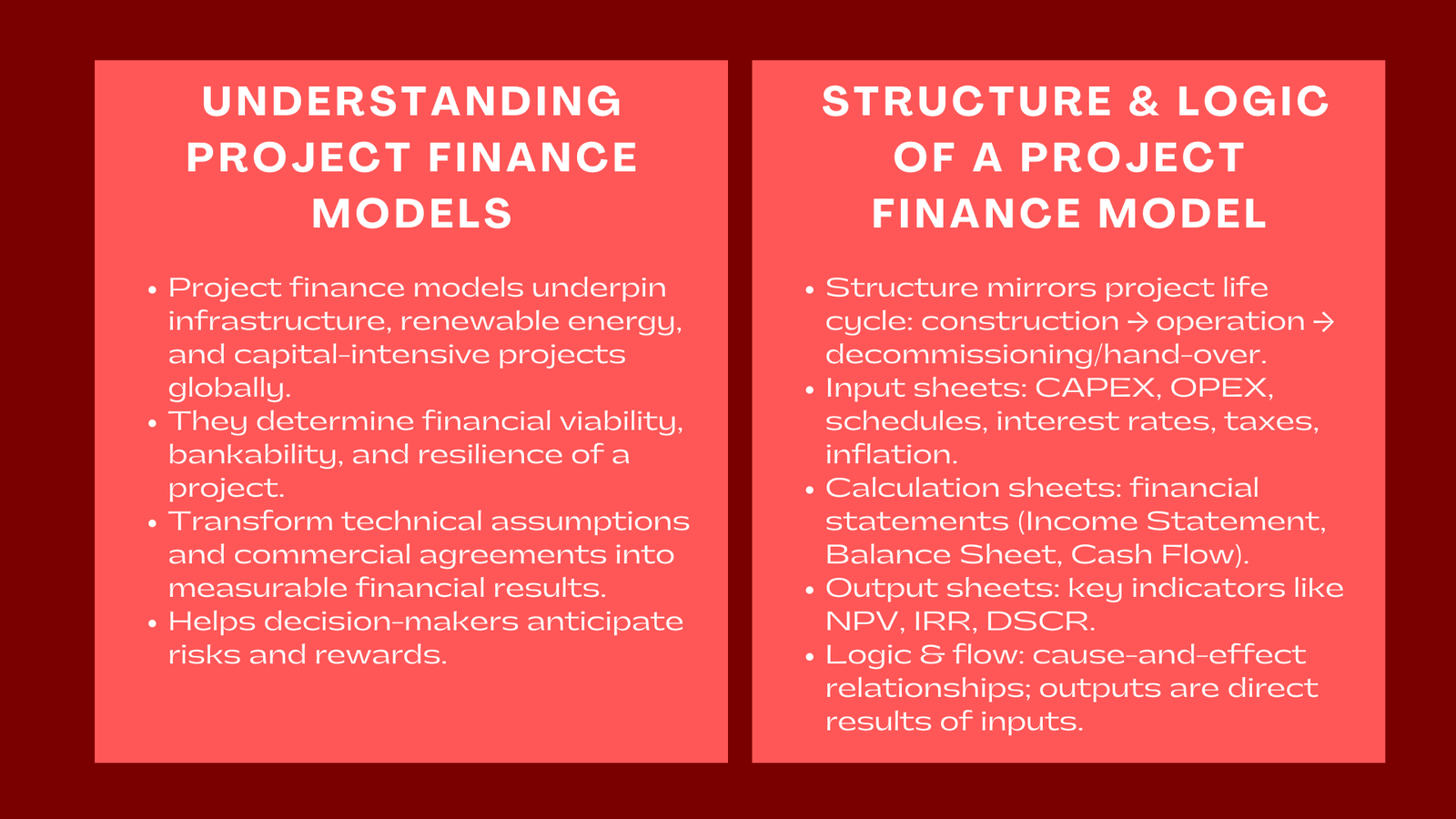
The Foundational Structure of a Project Finance Model
Project finance model structure will usually be in line with the project life cycle in which the model represents project construction, then operation and finally decommissioning or hand over. The phases require different patterns of cash flows, risks and financing structures which should be described correctly in the model.
The project finance model has generally an input sheet; these consist of the project assumptions. They are the capital expenditure (CAPEX), operating cost (OPEX), project schedules, inflation levels, interest rates, and tax parameters. The simplicity and ease of this input section establish in which the model can be modified with changes in real-world scenarios.
The model then advances to calculation sheets which include the construction of financial statements (income statement, balance sheet, and cash flow statement). The calculations combine project presuppositions with project incomes and expenditures, taxes, and financing operations. Following project finance model best practices Singapore, the summary sheet of the financial indicators such as net present value (NPV), internal rate of return (IRR), and debt service coverage ratio (DSCR) is presented in these intermediate computations in output sheets. These products are the main components of making decisions based on which investors and lenders determine the viability of the project.
It is not a random structure but it is constructed to keep it clear and consistent. All the figures should be identifiable and there should be a rational and clear relationship between inputs, calculations, and outputs. Initially, to those who are not experienced programmers, this kind of structure is important in the creation of models that can easily be reviewed and audited by others.
Logic and Flow: How Project Finance Models Think
Other than structure, logic is what gives the project finance model its ethical wholeness. The logic establishes the path of flow of information in the model and the way the relationship between two variables is created. Project finance model has to operate on the principle cause and effect: all the outputs have to be the logical outcome of certain inputs and assumptions.
Indicatively, the capital expenditure incurred in the project should be directly affected by the cost of construction and this has an impact on the depreciation, financing requirement and finally cash flow availability. Similarly, the projection of revenue must be pegged on actual operational assumptions like production capacity, the mechanisms of pricing, and market demand as opposed to arbitrary assumptions. This sequence of reasons makes the model work effectively in simulating the manner in which the project is likely to act in various circumstances.
Time consistency is also observed in a sound financial model. Given that most project finance models are constructed in a time scale of 15-30 years, the occurrence of cash flows and cash outflows is to be adjusted according to the actual schedule of the project operating. An example is that loan repayments can not commence until the project has been commissioned and is in revenue generation. This ensures financial realism and credibility keeping these logical time relationships.
The other characteristic of good modeling logic is transparency. The ability to explain the derivation of outputs should be available to the stakeholders, more so the lenders and the auditors. Participating in project finance modelling for managers in Singapore emphasizes this principle. In this regard, model non-formulas should not be too complicated or deeply embedded and should have both references and naming conventions and documentation. An easy-to-follow model will create confidence and minimize the errors that might take place during an audit or due diligence.
Why Logical Structure Matters in Project Financing
The significance of a logical model goes much further than the accuracy of the spreadsheet. Financial models are the focus of project finance in negotiations, risk assessment and contracts. The poor form of the model may provide false information about the project performance, with subsequent financial choices or the wrong expectations of stakeholders.
The model is developed well thus enhancing better communication among the participants of the project. The engineers, financiers and legal teams are usually of different disciplines but use the model as a reference point of analysis. As long as the structure and logic of the model is uniform, the model will make it a universal language where the parties can interpret financial results according to their respective expertise.
Besides, logical modeling provides scenario and sensitivity analysis that are important in project finance. The stakeholders can determine how resilient the project will be with varying conditions by changing a few of its major assumptions, including the cost of construction, the level of operating efficiency or the interest rates. Such capability will enable investors and lenders to recognize the key risks and establish mitigation approaches, including the leverage level or changing the terms of the contracts.
Finally, the project finance model incorporates the logic that renders it more of a forecasting tool than a strategic tool. It enables the decision-makers to look beyond the figures and realize the way in which different forces interact with each other and how to arrange deals in such a way that will be sustainable during the life of the project.
Conclusion
The acquisition of knowledge of the structure and logic of a project finance model is a key consideration for someone who wants to become a part of a complicated financing agreement. The rationality and transparency of a model are the sole reasons to ascertain the level of trust that investors and lenders can have in the findings of a model. In project finance, where billions of dollars and decades of devotion are usually involved, credibility is all–credibility that starts with the structure of models.
To new initiates, this is the initial structure that should be mastered on the way to becoming a good financial modeler. Models get more complex as the project size and complexity increase and the sophisticated models include debt sculpting, tax optimization, and refinancing cases but the basic principle remains; with every input there should be an output and every output should be a consistent financial story.
A proper project finance model is not simply a spreadsheet, the model is a living organism of how the project will perform, evolve over time and create value. Having learned to structure and be logical, professionals can make financial modeling more than a technical task and a strategic benefit and will build smarter investments and resilient infrastructure in the world.



